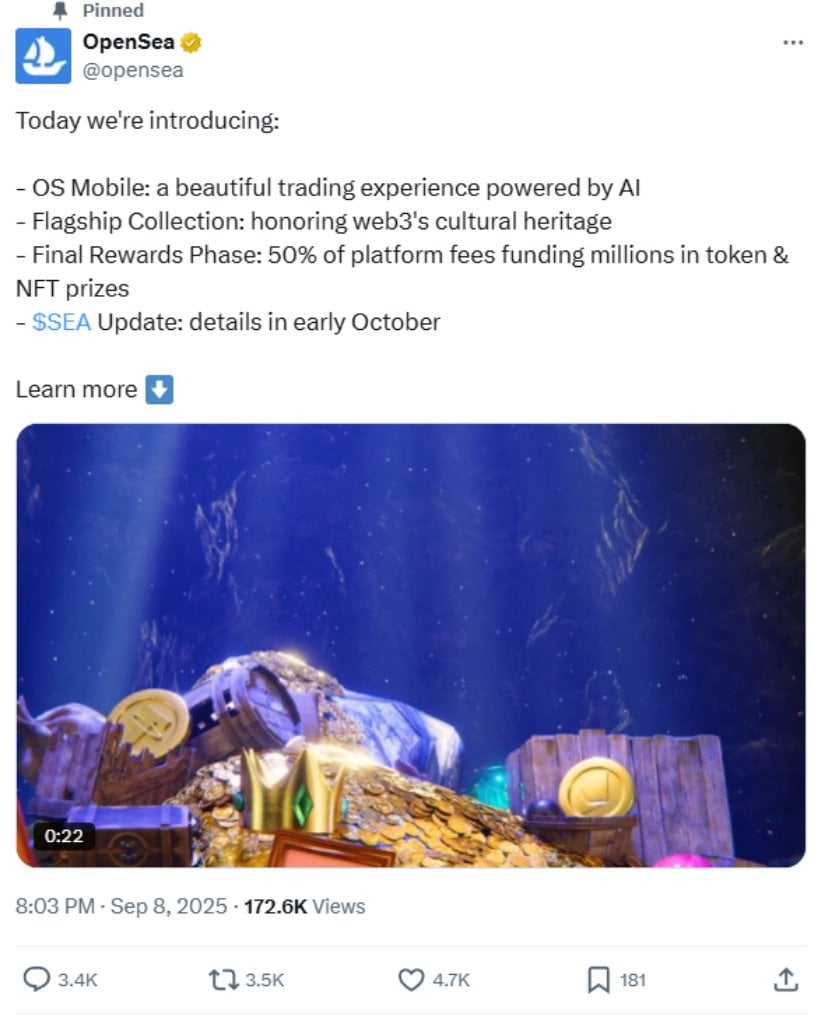
The company is creating a $1 million “Flagship Collection” treasury while preparing to launch its highly anticipated SEA token, marking a major shift in strategy to reclaim market dominance.
Building Digital Culture Through Strategic NFT Reserves
OpenSea’s new Flagship Collection represents the platform’s first formal NFT reserve. The initiative will showcase NFTs as cultural artifacts while supporting the artists and collectors who shaped the space. The collection begins with purchasing CryptoPunk #5273, with selection overseen by OpenSea employees and trusted external advisors.
“We’ve always said NFTs are culture,” OpenSea CEO Devin Finzer stated. “The Flagship Collection is about picking the pieces we believe will stand the test of time.”
This treasury strategy follows similar moves by other companies. GameSquare previously purchased a rare CryptoPunk for $5.15 million worth of preferred shares for use as a treasury asset, showing growing institutional adoption of NFTs as reserve holdings.
SEA Token Brings Massive Prize Vault System
The SEA token launch comes with an ambitious reward system. According to announcements from earlier this year, OpenSea will dedicate 50% of all platform fees to a “massive prize vault” that gets distributed to users as rewards. The vault already contains $1 million worth of OP and ARB tokens.

Source: @opensea
Users can access “Treasure Chests” through the rewards portal. These chests can be leveled up through daily challenges, with higher levels earning larger shares of the prize vault. This gamified approach aims to encourage long-term engagement rather than short-term speculation.
The SEA token announcement has already created major market impact. OpenSea’s market share jumped from 25.5% to 71.5% in recent weeks, with daily trading volume increasing nearly five times to $17.4 million.
Platform Overhaul with OS2 Technology
OpenSea’s OS2 platform represents a complete rebuild from the ground up. The new system supports token trading across 19 blockchains, allowing users to buy NFTs on one chain using tokens from another. This cross-chain functionality addresses a major pain point for users managing assets across multiple networks.
The platform now combines NFT and fungible token trading in one interface. Marketplace fees have dropped to 0.5%, while swap fees are eliminated entirely during the launch period. These reduced costs help OpenSea compete more effectively with other platforms.
OS2 also introduces the “Voyages” rewards system, where users earn XP points for activities like sharing galleries, completing swaps, or buying NFTs. While OpenSea hasn’t confirmed that XP converts directly to SEA tokens, the company monitors “meaningful” and “organic” activity for future rewards.
Regulatory Clarity Boosts Confidence
A major positive development came when the SEC closed its investigation into OpenSea. The regulator had issued a Wells notice in August 2024, indicating potential enforcement action. This closure removes significant regulatory uncertainty that had pressured the entire NFT market.
The decision also benefits other NFT platforms. LooksRare’s native token saw increased activity following the announcement, with active addresses rising approximately fivefold compared to usual figures.
Token Distribution and Eligibility
Unlike many crypto airdrops, the SEA token distribution won’t require identity verification. U.S. users remain eligible to participate, broadening the potential recipient base significantly.
Eligibility criteria focus on platform usage rather than holding specific amounts. Historical OpenSea activity will be rewarded, including NFT trading volume across multiple supported chains like Ethereum, Polygon, BNB Chain, and Arbitrum. OpenSea has indicated that engaging with competitors could negatively impact airdrop scores.
Certain NFT collections provide XP multipliers for trading activity. Doodles and Kaito Genesis offer 5x boosts, while Pudgy Penguins provides 4x multipliers. Azuki, Bored Ape Yacht Club, and Milady Maker collections all give 3x boosts to users.
The OpenSea Foundation will oversee token distribution and governance. Unlike typical marketplace tokens focused on fee discounts, SEA is designed as a governance token giving holders voting rights on protocol upgrades, incentive design, and treasury decisions.
Market Recovery Shows Strong Momentum
OpenSea’s transformation comes as the NFT market remains far below peak levels. At its height in May 2022, the platform facilitated $2.7 billion in daily trading volume. Current volumes rarely exceed single-digit millions, representing a significant decline from peak activity.
However, recent metrics show encouraging trends. OpenSea facilitated trading of $190 million worth of NFTs in recent monthly periods. The platform’s monthly trading volume is down significantly from a $5 billion peak in early 2021.
CEO Devin Finzer acknowledged the company’s evolution: “We took a step back with this rebuild and said: We want to build long-term for our community. We want to be much more crypto-native.”
What This Means for Digital Assets
OpenSea’s dual approach of building cultural NFT reserves while launching a governance token represents a maturing marketplace strategy. Rather than competing solely on fees or features, the platform is positioning itself as a long-term steward of digital culture.
The $1 million treasury and ongoing fee allocation to user rewards creates sustainable value beyond token speculation. Combined with regulatory clarity and technical improvements, these changes position OpenSea to lead the next phase of digital asset adoption.
As Finzer noted: “It’s the biggest moment in our history, but it’s also just the beginning.”


 3 months ago
64
3 months ago
64 










 Bengali (Bangladesh) ·
Bengali (Bangladesh) ·  English (United States) ·
English (United States) ·